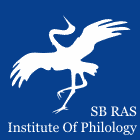 |
|
||||||||||||
|
Institute of Philology of
the Siberian Branch of Russian Academy of Sciences |
|
||||||||||||
|
|||||||||||||
DOI: 10.25205/2307-1737 Roskomnadzor certificate number Эл № ФС 77-84784 | |
| Kritika i Semiotika (Critique and Semiotics) | |
|
Article
Authors: Mikhail Ya. Dymarsky Herzen State Pedagogical University of Russia, St. Petersburg, Russian Federation; Institute for Linguistic Studies of the Russian Academy of Sciences, St. Petersburg, Russian Federation
Abstract: The article considers the syntactic model illustrated in the title, which is treated in the academy Russian Grammar as a phraseologized realization of a complex sentence of an unsplit structure with an unoriented anaphoric pronominal link. The model has a contaminated character, due to which its unambiguous assignment to any of the standard taxa of the structural-semantic classification of complex sentence is impossible. The structure of the model (its immediate systemic environment, the role of the words chto and to, etc.) is considered. The interpretation of the model as an expressive means of interpretive syntax, which developed on the basis of the complex sentence, but broke away from it and actually turned into a model of a simple sentence, is substantiated. Two varieties of the model are revealed: with the operation of identification and with the operation of establishing correspondence. In the first variety, the element to has a pronominal character, while in the second this character is weakened and the same element is closer to a particle. The semantics of the model is analyzed, in which the elements of hyperbolization, metonymization and metaphorization are distinguished. The varieties of the model have an unconditional interpretative potential, which is based on the hyperbolization provided by the generalized-concessive component of the construction. In the variety with the operation of establishing correspondence, the interpretive potential of the construction is enhanced by the possible presence of metonymic transfer, in the second – by the possible presence of metaphorization. In general, the construction is one of the bright phraseological means of interpretive syntax. Keywords: Russian language, syntax, generalized-concessive construction, identification construction, contamination, phraseological syntactic model, hyperbolization, metonymization, metaphorization, interpretive syntax Bibliography: Ardentov B. P. “Chto” v sovremennom russkom yazyke [“Chto” in the contemporary Russian]. Kishinev, 1973, 90 p. (in Russ.) Kuznetsova R. D. Istoricheskie izmeneniya v slozhnopodchinennom predlozhenii [Historical changes in a complex sentence]. Kalinin, 1983, 88 p. (in Russ.) Nikolaeva T. M. Prostranstvo slavyanskikh partikul [The space of slavic particles]. In: Nikolaeva T. M. Lingvistika. Izbrannoe [Linguistics. Selected works]. Moscow, Yazyki slavyanskoi kul'tury Publ., 2013, pp. 161–183. (in Russ.) Steksova T. I., Shmeleva T. V. Russkoe iz''yasnitelnoe predlozhenie v diskursivnom prostranstve [Russian complex sentence with object clause in discursive space]. St. Petersburg, Dmitry Bulanin Publ., 2022, 288 p. (in Russ.) Shvedova N. Yu. (ed.). Russkaya grammatika [Russian grammar]. In 2 vols. Moscow, Nauka, 1980, vol. 2: Syntax, 712 p. (in Russ.) |
 |
Institute of Philology Nikolaeva st., 8, Novosibirsk, 630090, Russian Federation +7-383-330-15-18, ifl@philology.nsc.ru |
© Institute of Philology |


